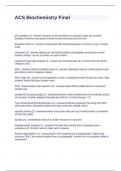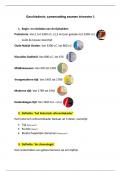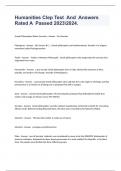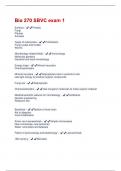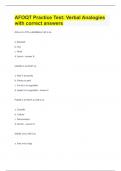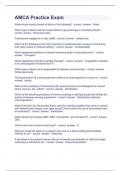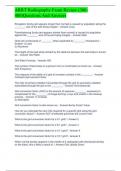ACS Biochemistry Final
pKa (chapter 3) - answer measure of the tendency of a group to give up a proton
(acidity); tendency decreases tenfold as pKa increases by one unit
thioester bond (1) - answer compounds with functional group C-S-CoA-C (eg, in acetyl-
CoA)
zwitterion (3) - answer dipolar ion with both positive and negative groups but overall
neutral charge; can act as either an acid or base
Isoelectric point (pI) (chapter 3) - answer the characteristic pH at which the net electric
charge is zero
SDS - Sodium Dodecyl Sulfate (chap 3) - answer detergent used to unfold proteins and
give them uniform negative charge
SDS Page (3) - answer chromatography used to separate proteins based on mass. light
proteins travel fast than heavier ones
PCR - Polymerase chain reaction (3) - answercopies DNA multiple times to increase
sample size
Isoelectric focusing (chapt 3) - answerprocedure used to determine the isoelectric pt (pI)
of a protein. Protein migrates through gel until pH = pI (net charge = 0)
Two-Dimensional Electrophoresis (3) - answercombines isoelectric focusing and SDS
electrophoresis; separates proteins by both molecular weight and pI
specific activity (3) - answernumber of enzyme units per mg of total protein (a measure
of enzyme purity)
activity (3) - answertotal units of a certain enzyme in a solution
Peptide bonds (chapter 4) - answerC-N bond with double bond character due to
resonance (C-N bond cannot rotate, and is planar)
Edman degredation (3) - answerused in the sequencing of polypeptides; labels and
removes ONLY the amino-residue from a polypeptide. carried out in a machine called a
sequenator
, φ in peptide bonding (chapter 4) - answerangle around the α-carbon - amide nitrogen
bond
ψ in peptide bonding (chapter 4) - answerangle around the α-carbon - carbonyl carbon
bond
Ramachandran Plot (4) - answershows favoreable φ-ψ angle combinations. 3 main
"wells" for α-helices, β-sheets, and left handed α-helices
Levinthal's Paradox (4) - answerprotein folding cannot be a completely random, trial and
error process
chaperonins (4) - answerelaborite protein complexes required for the folding of a
number of cellular proteins that do not fold spontaneously
Henderson-Hasselbach Equation (2) - answerpH = pKa + log([A-]/[HA])
which amino acids are not found in α-helices? (4) - answerglycine and proline. glycine is
too flexible, proline is too rigid to rotate.
which amino acids are commonly found in β turns? (4) - answerglycine, because it is
small and flexible, and proline because it forms cis conformation in tight turns.
β-mercaptoethanol (4) - answerbreaks disulfide bonds
circular dichroism (4) - answertechnique that measures the amount of helical structures
in macromolecule (protein is denatured)
Acid Dissasociation constant Ka (2) - answerquantitative measure of the strength of an
acid in solution
Native Fold - answer
Size-exclusion chromatography (3) - answerSeparates proteins according to size. Large
proteins emerge from the column before small ones (counterintuitive result). The solid
phase consists of beads with engineered pores or cavities of a particular size. Large
proteins cannot enter the cavities, and so take a short (and rapid) path through the
column, around the beads. Small proteins enter the cavities, and migrate through the
column more slowly as a result
Affinity chromatography (3) - answerbased on the binding affinity of a protein. The
beads in the column have a covalently attached chemical group. A protein with affinity
for this particular chemical group will bind to the beads in the column, and its migration
will be retarded as a result
pKa (chapter 3) - answer measure of the tendency of a group to give up a proton
(acidity); tendency decreases tenfold as pKa increases by one unit
thioester bond (1) - answer compounds with functional group C-S-CoA-C (eg, in acetyl-
CoA)
zwitterion (3) - answer dipolar ion with both positive and negative groups but overall
neutral charge; can act as either an acid or base
Isoelectric point (pI) (chapter 3) - answer the characteristic pH at which the net electric
charge is zero
SDS - Sodium Dodecyl Sulfate (chap 3) - answer detergent used to unfold proteins and
give them uniform negative charge
SDS Page (3) - answer chromatography used to separate proteins based on mass. light
proteins travel fast than heavier ones
PCR - Polymerase chain reaction (3) - answercopies DNA multiple times to increase
sample size
Isoelectric focusing (chapt 3) - answerprocedure used to determine the isoelectric pt (pI)
of a protein. Protein migrates through gel until pH = pI (net charge = 0)
Two-Dimensional Electrophoresis (3) - answercombines isoelectric focusing and SDS
electrophoresis; separates proteins by both molecular weight and pI
specific activity (3) - answernumber of enzyme units per mg of total protein (a measure
of enzyme purity)
activity (3) - answertotal units of a certain enzyme in a solution
Peptide bonds (chapter 4) - answerC-N bond with double bond character due to
resonance (C-N bond cannot rotate, and is planar)
Edman degredation (3) - answerused in the sequencing of polypeptides; labels and
removes ONLY the amino-residue from a polypeptide. carried out in a machine called a
sequenator
, φ in peptide bonding (chapter 4) - answerangle around the α-carbon - amide nitrogen
bond
ψ in peptide bonding (chapter 4) - answerangle around the α-carbon - carbonyl carbon
bond
Ramachandran Plot (4) - answershows favoreable φ-ψ angle combinations. 3 main
"wells" for α-helices, β-sheets, and left handed α-helices
Levinthal's Paradox (4) - answerprotein folding cannot be a completely random, trial and
error process
chaperonins (4) - answerelaborite protein complexes required for the folding of a
number of cellular proteins that do not fold spontaneously
Henderson-Hasselbach Equation (2) - answerpH = pKa + log([A-]/[HA])
which amino acids are not found in α-helices? (4) - answerglycine and proline. glycine is
too flexible, proline is too rigid to rotate.
which amino acids are commonly found in β turns? (4) - answerglycine, because it is
small and flexible, and proline because it forms cis conformation in tight turns.
β-mercaptoethanol (4) - answerbreaks disulfide bonds
circular dichroism (4) - answertechnique that measures the amount of helical structures
in macromolecule (protein is denatured)
Acid Dissasociation constant Ka (2) - answerquantitative measure of the strength of an
acid in solution
Native Fold - answer
Size-exclusion chromatography (3) - answerSeparates proteins according to size. Large
proteins emerge from the column before small ones (counterintuitive result). The solid
phase consists of beads with engineered pores or cavities of a particular size. Large
proteins cannot enter the cavities, and so take a short (and rapid) path through the
column, around the beads. Small proteins enter the cavities, and migrate through the
column more slowly as a result
Affinity chromatography (3) - answerbased on the binding affinity of a protein. The
beads in the column have a covalently attached chemical group. A protein with affinity
for this particular chemical group will bind to the beads in the column, and its migration
will be retarded as a result

